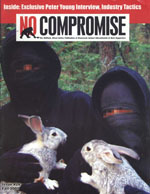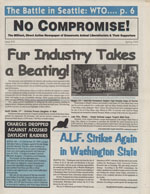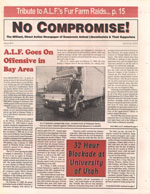» Next Entries
The Archives
-
No Compromise, Periodicals
No Compromise #27-28
03.18.13 | PermalinkNo Compromise #27-28 (2005. Santa Cruz / San Francisco, CA)
The volunteer staff of No Compromise may have only published two issues in 2005, but both were valuable sources of news and ideas from across the globe. As always, the reports inside are bitter sweet. Many animals were rescued, many abusers felt some heat, and many people rose up and fought back. Then, there was the backlash, the senate hearings, and the arrests. The movement has never stopped though, and No Comp always served as a reminder that come hell or high water we were all going to forge ahead, sometimes stronger, sometimes weaker.
One unfortunate development in 2005 was the arrest and conviction of Chris “Dirt” McIntosh. Despite receiving movement support, Chris turned to Nazi groups in prison for advice and friendship. Soon, he counted himself among their ranks, and requested to be removed from animal lib prisoner lists. He would have been removed anyway though: there is never room in our struggle for a Nazi!
Luckily, other prisoners continued to show courage, dignity, and resolve from behind bars. Both 2005 issues of NC contain inspiring letters and interviews with jailed comrades. All in all, this is another must read year for the best animal liberation publication to come out of the United States.
…
-
No Compromise, Periodicals
No Compromise #23-26
02.17.13 | PermalinkNo Compromise 23-26 (2004, Santa Cruz / San Francisco, CA)
One of the lessons that archiving old animal liberation publications has taught me is that the most extreme actions have rarely produced much in the way of results for animals. A public that already sees veganism as odd might still see the value of rescuing animals from a laboratory, but will never support a car bombing. When innocents are injured, or when murder was the goal, the backlash starts to creep into our own ranks, and as we fracture law enforcement and industry groups take advantage. In the end, I can think of no bombing (or contamination, or grave robbing, etc.) which advanced the cause of animal rights more than it harmed it. This is not to say that bombings and the like could never be successful. At later stages of many revolutionary struggles, when the majority of the public supports the cause, bombs can clear away in one night what years of protest could not. While a movement is in its infancy, however, it could be argued that more often than not bombs blow up in our faces.
And so it was in 2004 when a group calling itself the Revolutionary Cells Animal Liberation Brigade carried out two bombings of HLS related targets in California. The movement was left to make lemonade from truly shitty lemons, and No Compromise did their best to mitigate the harm of the actions while keeping activists focused on the real enemy.
The year continued with the indictment of the SHAC 7, the emergence of Austria as a leader in the movement, and some exciting open rescues. Sarahjane Blum and Ryan Shapiro’s organization, GourmetCruelty.com, carried out one such operation that piqued public interest and eventually resulted in a sympathetic program on Animal Planet. Elsewhere Gina Lynn was imprisoned for defying the Seattle grand jury, Billy Cottrell was arrested for a massive SUV dealership arson, and the Universtiy of Iowa was treated to the most sophisticated lab raid to occur since the early 90s.
Every time we post a year of No Compromise we say the same thing: that this is essential reading for those who wish to understand the recent history of our movement. This posting is no exception. No Compromise was the best AR publication of its era, and 2004 saw the publication refining its strengths and providing their readers with four of the best issues yet.
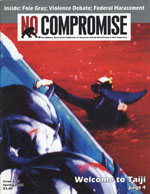



-
No Compromise, Periodicals
No Compromise #18-19
10.23.12 | PermalinkNo Compromise #18-19 (2001-2002. Santa Cruz, CA.)
If you have been following our posting of the complete No Compromise than you have read along as the new, 1990s militant grassroots took its first steps, stumbling along an exciting, and at times error filled path towards animal liberation. Those early years saw a lot of dedication and courage, but sadly little in the way of new tactics or intelligent planning.
That all changed in 2001 with the arrival of the anti-HLS campaign in the United States. The focus suddenly shifted from scattershot regional targeting to a single, international pressure point and the results were encouraging.
2001 wasn’t just about the fight against Huntingdon. The tactics developing in that one small struggle were inspiring activists globally to step up the fight against all areas of animal abuse, and sadly, some of our friends ended up in prison as a result. The support of these jailed comrades was inspiring, but our movement was dealt a terrible blow as Barry Horne died on Hungerstrike. That was not the only tragedy we would witness in these 12 months. Jeff Luers was sentenced to nearly 23 years in prison for an act of sabotage which harmed no one. Animal liberationists had been a strong force in the growing movement against globalization of capitalism, and at the 2001 G8 summit we watched as protestors and media were brutalized and bloodied in the lead up to the police murder of Carlo Giuliani. And of course, non-humans continued to be slaughtered in endless, unfathomable numbers. The tone of these two issues of No Compromise may have been optimistic, even cocky, but those of us on the ground knew that times were tough and getting tougher.
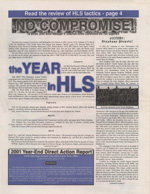

-
Campaign newsletters, Most Popular
More SHAC USA newsletters
09.22.12 | PermalinkSHAC USA Volume 2, issues 2 and 4 (2002, Philadelphia, PA)
It is hard to describe the feeling of constant elation that I had working on the campaign against Huntingdon Life Sciences. After years of grassroots organizing it seemed that the movement was finally moving forward with speed and determination. News constantly poured in from all corners of the globe that a new target had been chosen- and eliminated. Everyone participating was energized, hopeful, and on the attack.
One of the reasons that so many people were inspired to take action against HLS was the SHAC USA newsletter. Each issue featured the groundbreaking graphic design work of Jake Conroy. His layouts and other artistry made each copy a pleasure to behold, and also left other organizations scrambling to improve the designs of their own publications. If you doubt that a periodical could prompt someone to pickup a sign, bullhorn, or brick, than you feel very different than the US Government. They were so threatened by Conroy’s print and web work that he was indicted in the SHAC 7 case, and received one of the longest sentences of all of the defendants.
These two issues of the newsletter date from 2002, which was an exciting time in the campaign. After Stephens Inc. had capitulated, thousands of people suddenly had faith that they could, in fact, change the world. We all knew that we were a part of something special, and I think that comes across in the text and imagery of of these two movement gems. Sure, we were cocky, our rhetoric sometimes went too far, and we weren’t always as organized or prepared as we claimed- but we walked our talk to the best of our ability and our efforts took the movement far.

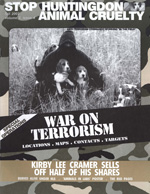
-
No Compromise, Periodicals
No Compromise #15-17
09.01.12 | PermalinkNo Compromise #15,16, 17 (2000-2001, Santa Cruz, CA.)
I want to preface this post with this: The turn of the century was an epic time to be alive and fighting! Between the WTO riots, a huge upsurge in ALF attacks on the West Coast, some inspiring support of grand jury resisters, and the migration of the SHAC campaign to the United States, there were also thousands upon thousands of other actions across the planet. It was hard to keep up with all of the news because it seemed that people everywhere had finally taken enough and were beginning a counter strike for non-humans, wilderness, and human freedom. Luckily, No Compromise kept track of most of the action, and produced three excellent issues during this incredible year of revolt. Beyond the coverage of the latest direct actions, attention was also paid to our past successes and failures- and all animal activists would do well to read issue #16’s “Blast From The Past” article about lab raids in the 1980s.
…
-
One-off publications
Let’s Get Free
07.23.12 | PermalinkLet’s Get Free (2002, Eugene, OR.)
Once upon a time in the late 1990s I was down in southern California for a big activist gathering and protest. A local Food Not Bombs chapter was preparing a meal to feed the demonstrators the following day, and I ended up chopping vegetables next to this nice punk kid. At some point it came up that I was living in Eugene, and he mentioned that he might move there. We promised to keep in touch, and a little while later I saw him at a protest in front of Eugene’s federal building. “I’m sorry man, I’m terrible with names,” I apologized. “Call me Free,” he said.
Free became a very recognizable face during an interesting shift in the membership of Earth First! I had grown up in Eugene during a time when the “Rednecks for Wilderness” generation were losing ground to patchoulied, pacifist hippies. No one would have guessed that just a little more than a decade later the hippies would find themselves ousted by eco-crusties, but the change of guard can’t be stopped, and Free was right there in the center of it.
Everyone liked the guy, you couldn’t help it. The punk kids looked up to him because he walked his talk. The pacifists may not have appreciated how willing he was to literally fight for the planet, but even Julia Butterfly called him to discuss his near-record tree sit. Hell, the cops gave him a kind of grudging respect. He became a major part of the Eugene scene during a time that the struggle seemed to be accelerating, when we all felt like a revolution could break out at any moment. And then he was stolen away…
I had just defied a grand jury subpoena and was trying to quietly pass through Eugene. Stupidly, I stopped off for coffee at Out of the Fog, a little cafe that catered to the eco-defense and anarchist crowds. A loud voice yelled, “Man, I thought you were on the run!” It was Free, and suddenly everyone was looking at me. “Naw, man, it isn’t like that,” I muttered in the grumpy manner I am most known for. I took my coffee to go, bid Free goodbye, and then a few days later I heard the news. He had been arrested for an arson. Soon he would be sentenced to nearly 23 years in prison.
Let’s Get Free tells the story of Jeff “Free” Luers’ arrest, trial, and sentencing, along with some short articles and illustrations by Jeff himself. It was sold to benefit his legal defense fund and prison commissary fund before he eventually had his sentence reduced to about 10 years on appeal. It is a good zine, and it manages to capture some of the shock and anger felt by the activist community when one of our best comrades was buried inside the prison system as a reminder to stay in our place. What it doesn’t capture is the strength, sincerity, and warmth of Jeff Luers. I saw him recently, just a few days after my probation had ended. It had been more than 12 years since our last encounter and as he shook my hand and chatted I had to smile. The state failed to tame this young warrior. Free is free!
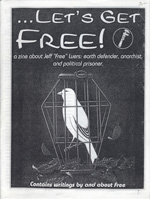
…
-
Most Popular, Periodicals, Videos
SHAC Revisited
07.02.12 | PermalinkSHAC USA Newsletters, Various Issues (2001-2006, Philadelphia, PA)
Diaries From Hell (2001, Princeton Junction, New Jersey)
The Mandate & Strike Back – Shac Videos (2002, Philadelphia, PA)Today marks the end of a very long journey for me. After more than two years on pre-trial release, eight months on house arrest, three years in prison, and three years on probation, my life is now my own again. As of this morning I no longer need to fill out monthly reports, open my home to law enforcement at any time without probable cause, give the government constant access to my e-mail and social media accounts, or stay confined within the western district of Washington. Best of all, I can return to the kind of organizing that I love and live the life of conscience that I committed myself to so many years ago.
The people who took away my freedom did not do so because I was breaking the law. In fact, they knew that I was not doing so. FBI documents show that I was under almost constant surveillance for years of my life. One field office after another followed me in an attempt to prove that I was “the nexus of illegal [animal and earth liberation related] crime in the Northwest.” They hired informants to befriend me, went through my garbage, paid off my mail carrier to write down the return addresses of my incoming mail, attempted to entrap me, raided my home… the list could go on and on. In the end they had some tapes of lectures I gave advocating forms of hacktivism, and for that speech activity I had my life interrupted for the better part of a decade. An appeals court later said this about my conviction: “Harper’s personal conduct does not cross the line of illegality; to punish him simply on the basis of his political speeches would run afoul of the constitution.” They then went on to uphold my conviction.
If all of the years stolen from me were not about crimes I had committed, what was the government’s motivation? The answer to that question is complex, but I believe the primary concern for the ruling class was that I had begun to see through their illusions of status and power. I know how grandiose- even absurd- that may sound, but please bear with me for just a moment. I was born to working class parents so poor that my first crib was made from a dresser drawer. My mother worked in convenience stores, cleaned homes, and toiled away her health in a frozen foods warehouse. My father was a Vietnam veteran who had survived a fire in the tank he was driving. The horror that he experienced in our government’s imperialist venture in south-east Asia colored every moment of our home life. He returned from his time in the army addicted to drugs, disabled, and in constant pain from shrapnel that was still lodged in his skull. He worked off and on as a mechanic and small time drug dealer. This is the situation that I was raised in, but I am not complaining. My parents loved me and my sister, and despite their mistakes they did their best to help me become a good person. My dad once saw two cops harassing a homeless man outside of a 7-11. They kept asking him if he was “an illegal” and made several references to his race, repeatedly calling him “amigo.” Everyone sat in their cars and watched. Everyone except for my dad, who got out and challenged the police. That moment taught me more than any private school or university ever could have. And while my mom couldn’t always afford the clothing that I selfishly demanded when I was kid, she never bowed down to anyone higher on the social ladder. When some entitled rich kid gave her shit at work, she gave it right back and then some. My heart swells with pride when I think about the warning she got from her bosses at one job: she was required to provide service to police officers and had better begin doing so or else she would be fired. After years of seeing the cops in Eugene, OR beat and harass the underclass she wouldn’t sell them coffee and doughnuts, and continued in her disobedience even when her job was on the line.
I always knew that no matter what my economic status was, that my life was just as valuable as that of a billionaire or a president. I do not care about their titles or money or connections, but I began to care an awful lot about their abuses of power. The wealthy elite, who strip this planet of its life support system, who benefit from racism, sexism, and homophobia, who view our non-human kin as machines for profit, who turn the masses against each other, are made of flesh and blood just like you and I. They want us to believe in corporate personhood because it distracts from the man behind the curtain, the vulnerable decision makers who use towers of steel and concrete to appear more powerful.
This was the threat of Stop Huntingdon Animal Cruelty; we saw through all of the social conditioning that tells us that we are too weak to effect change. We went straight to the homes of those in power, challenged them on their golf courses, screamed at them while they vacationed at summer homes. We were the barbarians at the gate, an alliance of the kind of people who did not usually get heard by the mega-rich of the world. Tooth and nail we went after their profits, and along the way refused to divide and fracture over broken windows or graffiti. Everyone was welcome if they would fight, and I smile so big it hurts when I think of the grandmothers, the punks, the students, and all the other unlikely comrades who marched together in defiance of the false hierarchy that tells us to keep separate and leave the rich to their own devices. We didn’t stay in our place. In fact, we recognized that our place was wherever the hell we chose, and the world of finance and animal abuse was rocked as a result.
This isn’t to say that we were perfect. We made so many mistakes, and we must be accountable for them. As Conflict Gypsy completes its archives of Huntingdon Life Sciences campaign materials we will be critical of the movement’s failures. But today, as I leave Washington to see my family and friends and celebrate my new freedoms, I hope that the spirit of the campaign will infect you. All of us have a revolutionary spark in our hearts, and together these individual sparks provide a beautiful warmth that melts away the cold sterility created by our rulers. Together we can turn the tide of ecocide, of prejudice, of economic and political exploitation. Never, ever believe otherwise.
For animal liberation, for global revolution, and for joy! Yours always,
Josh Harper
July 2nd, 2012




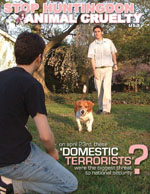

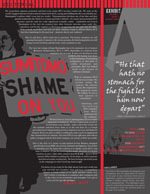


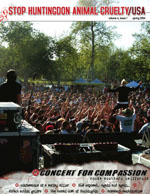




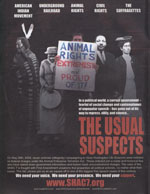


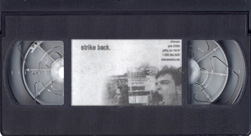
…
-
One-off publications
North American Earth Liberation Front Press Office Subcommittee on Eco-Terrorism
05.22.12 | PermalinkNorth American Earth Liberation Front Press Office Subcommittee on Eco-Terrorism (2002, Portland, OR)
One of the most frequently repeated myths about direct action is that is so damaging to public opinion that if people didn’t already do it, the government would in order to criminalize movements. If this were true it certainly seems that the system would spend less time trying to prevent radical action by silencing it’s proponents and more time harassing the Sierra Club. The truth is that nothing scares corporations and their paid-in-full politician pets like a well organized group with a willingness to fight and the ability to reach the public with their ideas.
In the late 1990s environmental sabotage was happening all across the world, but was particularly frequent in the northwest of the United States. At the forefront of these actions was the Earth Liberation Front, an anonymous, underground group, who utilized above ground spokespeople to reach the public. Their primary conduit for media relations was an activist from Portland named Craig Rosebraugh and his organization, the North American ELF Press Office. For his role in publicizing the motivations and rhetoric of the ELF he had his arm broken by the police, his home raided by Joint Terrorism Task Forces, his break cables cut, was repeatedly subpoenaed to grand juries, and eventually was called to testify before a congressional sub-committee who hoped to imprison him on contempt charges. The so-called “Eco-Terror committee” surely hoped that Craig would be an easy target, but that didn’t exactly work out for them. Snarky, educated, and angry, Craig’s testimony ran the gamut from stonewalling, to educational, to hilarious. For example, while running the Press Office with his friend Leslie James Pickering, Craig owned a bakery. When asked how the press office was funded, Rosebraugh simply replied “muffins.” When asked who had asked him to become the ELF press officer and how he was contacted, Craig responded, “Jesus Christ. It was a spiritual sort of thing.”
Jokes aside, a congressional subpoena represented a shift in the way environmental sabotage was being treated by the system, and publicizing that fact fell to Leslie James Pickering. In order to spread the word about the hearings, the NAELFPO sold a DIY booklet containing all of the testimony presented by both sides at the hearing and the subsequent written questions sent to Craig by the subcommittee. In a recent conversation with Conflict Gypsy about the booklet, Pickering had this to say:
“I can’t say for sure, how many of these were printed, but it was definitely less than 500. I had a little production line going, with people wearing gloves and hats, only half-jokingly, recently having learned about the WUO and Prairie Fire. The subcommittee was in February of 2002 and I left Portland in June of 2002. These booklets were produced somewhere in between there…probably March or April, because I utilized some machinery they had at college before the semester let out and because this was actually in peoples’ hands before it was easily found online. They were distributed through the ELF Press Office, which means that people could send us $10 and get a copy mailed, or get one at one of our event tables. A good chunk of them also went to AK distro, but we never saw a cent from those, which is another story. One of the more interesting aspects were the complaints from anonymous anarchists about it costing too much. This was when the PO was being bombarded with anonymous comments which were critical from many angles. I often think of how much work went into this and how cheap these people were, assuming for a moment that they weren’t all feds. If we didn’t have the old magnet scam going [where large magnets would be used to reset the copy keys at Kinkos – ed] we would probably have lost money at $10, because it was a pretty thick booklet.”

-
One-off publications
Inside / Out: Diary of Madness
05.08.12 | PermalinkInside / Out: Diary of Madness (2001, St. Louis, MO)
Back when the United States still had a strong grassroots animal liberation infrastructure, activists would regularly travel from all across the country to attend national demonstrations. Hundreds, or even thousands, of people would descend on various targets, and for a few days at least, bring the killers a little taste of the hell that they regularly created for non-humans.
Inside / Out is the story of Brenda Shoss’ experience at one such demonstration which took place in Little Rock between October 27th and 29th in 2001. Brenda, a devoted animal rescuer and mother, represented the broad diversity of the campaign against Huntingdon Life Sciences during it’s early years. Hailing from St. Louis, she hardly fit the image of “the usual suspects” in militant campaigning. Happily marching alongside pierced punks and anarchists, Brenda’s mild mannered and patriotic politics did not clash with those held by her comrades: instead her presence signaled a movement able to break through to a wider audience. Throughout her account of the demonstrations she evokes the anger and outrage that prompted thousands to band together, despite their differences, to fight to shut down HLS.
Following her personal reflections on the demonstration and overall campaign are excerpts from Michelle Rokke’s “Diaries of Despair,” an insider’s account of the horrors that happen behind the locked doors of Huntingdon, a company that continues to kill hundreds of animals a day in unnecessary and vicious experiments.
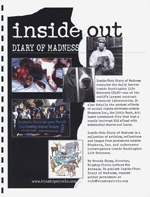
-
One-off publications
Elaho Valley Anarchist Horde on the end of the 7Cs: A Journal of Sasquatchology
04.23.12 | PermalinkElaho Valley Anarchist Horde on the end of the 7Cs: A Journal of Sasquatchology (2001, Victoria, Canada)
“The sun shines brightly in the yard, the sky is clear, the air fresh and bracing. Now the last gate will be thrown open, and I shall be out of site of the guard, beyond the bars, – alone! How I have hungered for this hour, how often in the past years have I dreamed of this rapturous moment – to be alone, out in the open, away from the insolent eyes of my keepers! I’ll rush away from these walls and kneel on the warm sod, and kiss the soil, and embrace the trees, and with a song of joy give thanks to Nature for the blessings of sunshine and air.” Alexander Berkman, Prison Memoirs of an Anarchist.
Upon my own release from prison I traveled to Seattle from Sheridan, Oregon to turn myself in to a halfway house. I too was an anarchist in the hands of the enemy, and while my incarceration was not as long or harsh as Berkman’s, his memoir contains long portions – sometimes entire pages – that feel so familiar it seems as though I wrote them myself. Several times in the final chapter he mentions a longing for wilderness, an urge to run from the dead cities of the northeast into the forests. On that ride from one lockup to another I knew why. Civilization is inherently confining, and even outside of the greybar hotel most of our lives consist of moving from one box to another in a continuous and agonizing march that we have little power to control. Looking out the windows of my friends car I wanted the passing sprawl to be sucked into the soil and replaced with life, beauty, and liberty.
The nature of incarceration can certainly make a person think about the incarceration of nature, but even those anarchists who have been lucky or smart enough to stay out of state custody often get it. If you are opposed to the artificial hierarchies of class, why support the equally arbitrary hierarchies based on species? If you think that forests have less worth than humans than I say you haven’t met enough cops! There isn’t one authority figure on earth I wouldn’t trade for a tree, and anyone who would argue the opposite is a moron. But forgive my rambling, I have written all the above because this wonderful DIY zine has sparked my sense of rebellion and wildness!
The end of the 90s and the early 2000s was a busy time for forest defenders, and across the globe direct action campaigns for wilderness were abundant and inspiring. There are many famous examples, and while Warner Creek and the anti-roads campaigns of England may have stolen the spotlight, one rugged crew in British Columbia carried on an overlooked battle that every activist should know about. If you like raging warrior grannies, sabotage, unlikely coalitions, and open revolt against corporations and their governmental subsidiaries, then you ought to read up on the history of actions in the Elaho, Squamish, and Simms valleys. This zine, written by members of the Elaho Valley Anarchist Horde as both a primer for new activists coming to the Elaho and a means of publicizing the campaign, is an excellent introduction.
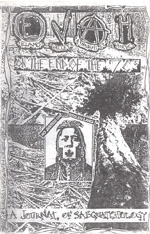
» Next Entries

